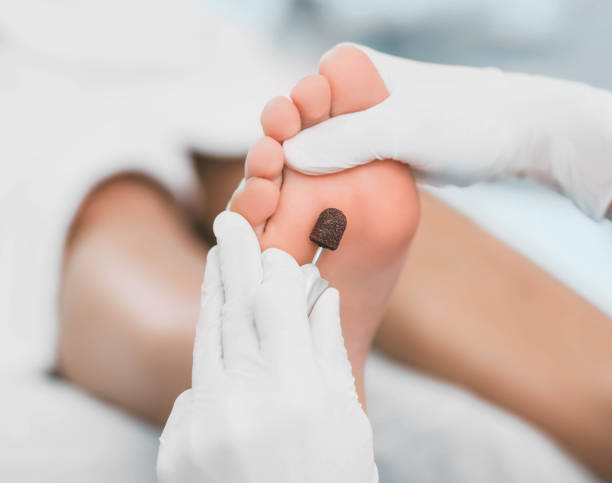 Orthotics are small, lightweight devices that fit inside your shoes to relieve pressure from sore areas of the foot and ankle. They are part of a podiatrist’s tool kit for treating many lower leg, foot and ankle problems.
Orthotics are small, lightweight devices that fit inside your shoes to relieve pressure from sore areas of the foot and ankle. They are part of a podiatrist’s tool kit for treating many lower leg, foot and ankle problems.
A good podiatrist will perform a comprehensive biomechanical exam of the lower legs and feet before prescribing foot orthotics. This will help identify any imbalances that may be contributing to your symptoms.
Reduced Blood Flow
A podiatrist is trained to identify issues that may be caused by poor circulation in your feet. This can include symptoms such as numbness or tingling in your feet, cold feet and ankles, swelling of the feet or legs and changes in skin color. Poor circulation is typically caused by a buildup of plaque in the blood vessels that reduces the flow of oxygen to your lower limbs. This condition is known as peripheral artery disease and it can lead to serious medical complications if not treated.
A podiatric assessment will determine your level of circulation and if necessary X-rays or other tests may be carried out to get a more detailed insight into your foot health. They will then recommend treatment options based on their findings.
One common treatment option is to prescribe shoe inserts called orthotics. These are designed to provide support and take pressure off of your feet and are usually effective for conditions such as diabetes, arthritic and flat feet. They can also help relieve pain that is associated with conditions such as plantar fasciitis, bursitis and arthritis.
Unlike premade orthotics that are available over the counter, a podiatrist will design a custom orthotic based on your needs and the type of shoes you wear. This ensures that the orthotics fit your feet perfectly and provides maximum benefit.
If you have chronic foot problems, a podiatrist may also recommend exercise and other treatment options. For instance, if you have arthritic foot joints that are causing pain, a podiatrist may prescribe a special pair of shoe inserts that can help improve your balance and comfort.
Rigid orthotic devices are often made from a firm material and are used to control function in the two major foot joints that lie directly below the ankle joint. They are commonly used for walking or dress shoes and they can improve your flexibility, decrease discomfort and alleviate strains in your foot and leg muscles. They can be especially beneficial for people who have jobs that require them to stand or walk for long periods of time and they can also help prevent or lessen the effects of diabetes, swollen or damaged toes, hammertoes, bunions and other conditions.
Damaged Nerves
The feet are a complex network of bones, muscles, tendons and ligaments. All of these elements must work together perfectly to keep you upright and moving. If any one of these components is damaged, the result can be pain and problems with movement. Podiatrist Bendigo can treat your foot and ankle injuries.
The podiatry exam starts with a review of your medical history and a physical examination of the foot and ankle. Your podiatrist will look for swelling, skin discoloration and other abnormalities. They may also test the function of the foot and toes by asking you to move them in different ways. They may also recommend imaging tests, such as X-rays, ultrasound and CT scans to look for bone fractures or blockages of blood vessels. They may also use MRIs to look for nerve damage.
Nerves in the foot can become compressed or pinched for many reasons, including ill-fitting shoes, repetitive pressure on the front of the feet and ankles and inflammatory conditions such as diabetes and rheumatoid arthritis. Symptoms of foot and ankle nerve damage include pain, numbness and tingling.
A podiatrist can treat nerve damage with medications, injections and orthoses. Medications include anti-inflammatory drugs that reduce swelling and pain and cortisone injections that help relieve inflammation and pain. Injections can be done in the office and may be repeated over time. Orthoses are custom made devices placed inside your shoe that alter the way your foot and ankle work. They can make your foot and ankle better fit your shoes, which can alleviate nerve-related pain.
Orthotics bendigo construct foot orthoses to adjust the way your foot and ankle function, aiming for a balance of stability and flexibility. They can also control the way your foot moves in your shoes, which can improve or eliminate strains and aches. Depending on your condition, your podiatrist might prescribe functional posted foot orthotics or rigid orthotics. Rigid orthotics are constructed from a plaster mold of your foot. These are a bit more expensive than the premade ones that you can find in shoe stores, ski and skate shops, pharmacies and sporting goods stores.
Poor Foot Biomechanics
Poor foot biomechanics are a common cause of pain in the feet. These can be due to flat feet, a fallen arch or excessive pronation (inward movement of the ankles during walking). Poor foot biomechanics can also lead to injury in other parts of the body. This is because your body compensates for any anomalies, placing extra stress on muscles, ligaments and tendons in other areas of the lower limbs.
A podiatrist can perform a full biomechanics assessment of your feet. They will ask you about your medical history and examine the structure of your feet, checking for any injuries or signs of infection. They will also look at how you walk and stand to see if your feet are aligned properly. They may also use X-rays and other imaging tests to get a better look at your feet.
They can then recommend a treatment plan. This might include prescription orthotics, a brace or other interventions to improve your foot and ankle alignment. They can also offer advice on footwear, exercise and other lifestyle changes to help prevent or manage your condition.
Prescription orthotics are custom made for you and your feet. They are very different from the store bought varieties you can buy at shoe stores, ski and skate shops or pharmacies. Store-bought orthotics only closely resemble your foot and aren’t designed to fit into the specific shape of your shoes. Custom orthotics are crafted to control your foot and promote healthy foot mechanics, which can prevent problems with other joints in the lower limbs.
If you have any issues with your feet, don’t wait to visit a podiatrist. The earlier you address any problems, the less likely they are to progress into serious and debilitating conditions like arthritis. A podiatrist can treat bunions, ingrown toenails, heel and back pain, poor circulation in the feet if you have diabetes and more. Contact a top-rated NYC podiatrist to book your appointment today. You won’t regret it!
Infections
The feet are extremely complex structures. They have 20 joints, 44 tendons, and 100 ligaments. They need to work together perfectly to keep you moving. This is especially true if you have a medical condition such as diabetes, which can cause foot problems like numbness, pain or even open wounds that can get infected. It is important to have any sore or infected foot looked at by a podiatrist to prevent further damage.
Infections can occur in the skin, adipose tissue, superficial or deep fascia, tendons and their sheaths, or any of the four major compartments of the foot. These infections can be minor, such as athlete’s foot or a plantar wart, or more serious, including a diabetic ulcer. Diabetic foot ulcers can be difficult to heal, particularly if the patient has peripheral vascular disease or diabetes mellitus. A podiatrist may recommend the use of antibiotics or amputation for severe ulcers that do not heal.
A podiatrist is also a good choice for people with recurring toenail fungal infections, which can be difficult to treat with over-the-counter products. A podiatrist can trim the infected toenail and prescribe antifungal medications that can help the nail recover.
People with nerve damage from conditions such as diabetes mellitus or alcohol abuse sometimes develop a sensation of burning feet. A podiatrist can help determine the cause of this condition and refer you to a specialist if necessary.
A podiatrist can also diagnose and treat a condition called Morton’s neuroma, which is a painful condition caused by a buildup of tissue between the third and fourth toe bones of the feet. It usually affects runners and can be aggravated by tight shoes or overpronation. A podiatrist can give you shots of medication to reduce inflammation and pain and help you find an orthotic that will relieve the pressure on your foot. Unlike over-the-counter arch supports or heel cups, orthoses are custom-made by a podiatrist to balance excessive pronation and supination. They are made of plastic, foam or other materials and can be constructed to include corrective and supportive elements.






